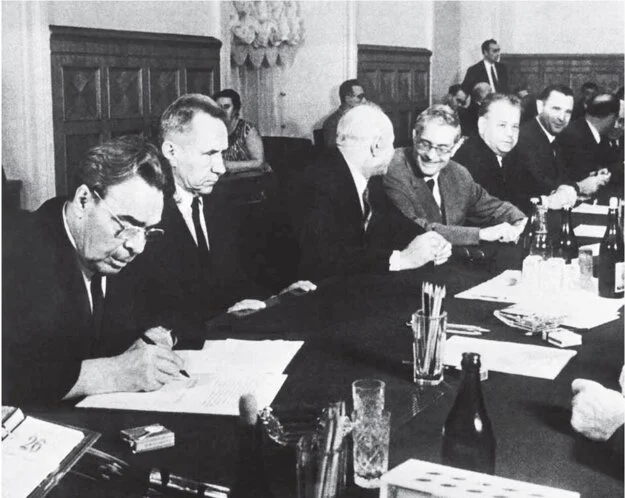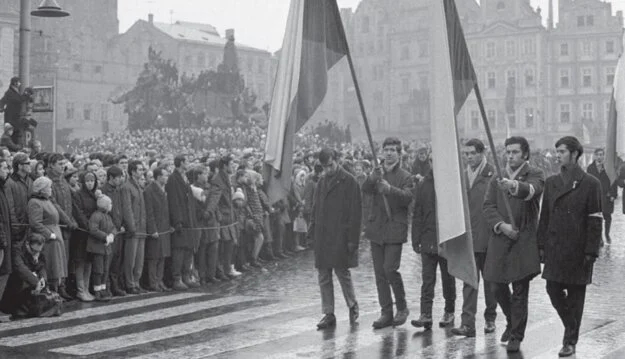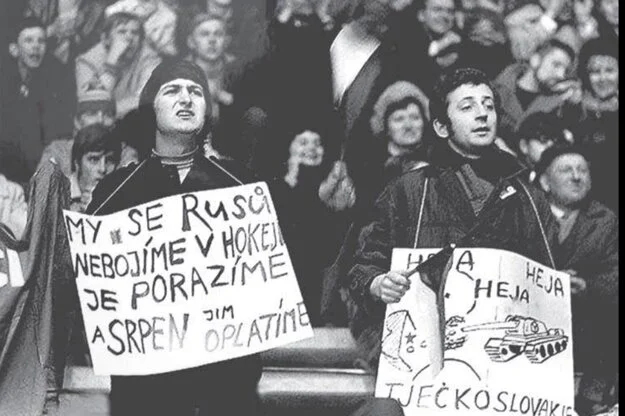Matej Šemšej wrote a thesis on the topic of the Warsaw Pact invasion of Czechoslovakia in 1968. In it, he also explored the expressions of citizen resistance leading up to the first anniversary of the invasion in August 1969.
After the representatives of the Czechoslovak government returned from negotiations in Moscow at the end of August 1968, following the Prague Spring—a period of political liberalisation and reform in communist Czechoslovakia during the spring of 1968, led by communist politician Alexander Dubček—and the invasion of Czechoslovakia by Warsaw Pact troops, a military alliance of communist states in Central and Eastern Europe led by the Soviet Union, on August 20-21, the situation in the country began to gradually stabilise in accordance with the Moscow Protocol.
The protocol called for the “normalisation of conditions”, which was reflected in the developments of the subsequent months. It effectively repudiated the Prague Spring reforms and re-established strict control and the suppression of dissent.
The Public Security (VB), the police force in communist Czechoslovakia; State Security (ŠtB), the secret police; as well as prosecutors, courts, the army, and the People’s Militias (ĽM) began to crack down more strictly on citizens who expressed any form of dissent against the presence of “friendly armies”.
In the autumn of 1968, public resistance remained widespread, and demonstrations continued in the streets for any state-related occasion, whether it was the formation of the federation, the anniversary of the creation of the First Czechoslovak Republic in 1918, or the Great October Socialist Revolution.
One of the triggers for the demonstrations was the signing of the infamous Agreement on the Temporary Stay of Soviet Troops in Czechoslovakia. The agreement was signed in Prague on October 16, 1968 and did not specify the term “temporary” or the number of Soviet soldiers to be stationed in Czechoslovakia.
After the signing, about 70,000 Soviet troops remained in the country. The “agreement” was more accepted in the working-class environment but faced significant opposition from the intelligentsia.
Especially among university students, it was seen as a result of Soviet diktat. Protests occurred on the very day it was signed.
As usual, the larger protests were in Bohemia and Moravia, but the most significant public protests in Slovakia took place in Bratislava, Žilina, Trnava, Prešov, Košice, Michalovce, Poprad, Zvolen, Liptovský Mikuláš, Levice, Trenčín, and Senica.
The student protests were joined by an increasingly broad spectrum of Slovak society. Participants in the demonstrations chanted protest slogans, tore down Soviet flags from flagpoles, and destroyed them.
The protests continued on November 6 and 7, 1968, in connection with the Soviet holiday—the Day of the Great October Socialist Revolution.
Emigration after the invasion
Immediately after August 21, 1968, an increasing number of residents began to leave Czechoslovakia. This exodus included citizens who had been abroad at the time of the invasion and were waiting to see how the situation in Czechoslovakia would develop.
In Hungary, there were many people who had been returning from holidays in Yugoslavia. Those who had holidayed in Bulgaria learned about the occupation from Bulgarian radio and press.
The Red Cross of Austria and Switzerland assisted Czechoslovak tourists in Vienna by setting up temporary accommodation camps for them. On September 6, 1968, the Czechoslovak press reported that around 15,000 citizens abroad were deciding whether to return home or not. Many citizens who were abroad at the time of the intervention eventually returned home.
However, many others began to leave Czechoslovakia (by December 1968, 6,384 people had emigrated from Slovakia, and from December 1968 to October 1969, an additional 4,223 citizens left). The number of emigrants from the Czech lands and Moravia was several times higher.
Citizens who could legally travel to the West during this period refused to return to their homeland (by July 31, 1971, 12,519 people from Slovakia had left and not returned).
In addition to the youth, who were the most common group of emigrants, intellectuals also left the country, as did those who had actively participated in “building socialism” until August 1968.
Not least, a significant number of residents emigrated for economic reasons rather than political ones. This included scientists, top doctors, athletes, and artists who, due to the lack of a party membership card or their opposition to the August occupation, could not fully realise their potential.
On May 27, 1969, President Ludvík Svoboda announced an amnesty aimed at encouraging the return of those who had decided to stay abroad after the military intervention. The deadline for the latest possible return was set for September 15, 1969.
Despite the press reporting a total of around 15,000 applications, only 565 people returned by the deadline. In 1969, a rather unusual situation arose in exile—those who had opposed each other 20 years earlier were reunited. For example, students who had been expelled from their studies for political reasons after the 1948 coup and those responsible for those expulsions met once again.
Palach
After a relatively calm end to 1968, the situation once again became dramatic in January 1969. The further developments in Czechoslovakia were significantly influenced by the open protest of Jan Palach, a student of history and political economy at the Faculty of Arts of Charles University in Prague. On January 16, Palach self-immolated in Wenceslas Square in Prague in front of passers-by, and three days later, he died from his injuries in the hospital.
In his honour, student hunger strikes, demonstrations, memorial gatherings, and marches were held across the country. The largest demonstration took place on January 20 in Prague, attended by tens of thousands of citizens from across the republic. The government considered these peaceful and quiet demonstrations as attempts by extremist forces to disrupt the “peaceful situation”.
The government viewed the situation as particularly critical on Saturday, January 25, 1969, the day of Palach’s funeral. They labelled this day as a “day of provocative actions by unspecified extremist forces”. Units of the National Security Corps were on full alert, and 16 representatives from seven major powers were expelled from Czechoslovakia.
Government officials did not officially attend Palach’s funeral. They quietly distanced themselves, not wanting to validate the public’s perception that the young student had become a national hero. Some officials also wished to avoid provoking the Kremlin. Citizens in Rome, Paris, Oxford, Oslo, and elsewhere also paid tribute to Palach’s memory.
Hockey
Following Palach’s death, tensions in Czechoslovakia began to rise once again. One of the significant peaks occurred at the end of March 1969. At the Ice Hockey World Championships in Stockholm, the Czechoslovak team defeated their Soviet opponents twice, leading to new large-scale demonstrations in Czechoslovakia.
Smaller demonstrations took place initially on March 21 after the first victory with a score of 2-0. However, the demonstrations on March 28, following Czechoslovakia’s 4-3 victory, were much more massive. Extraordinary state measures (100-percent alert status of the National Security Corps at many locations across the republic, heightened vigilance around Soviet command buildings, increased militia presence, etc.) indicated a tense night ahead.
The demonstrations in Wenceslas Square in Prague involved about 20,000 citizens, around 15,000 gathered in Liberec, and several thousand took to the streets in Ústí nad Labem, Brno, and Teplice. The largest demonstration in Slovakia saw approximately 2,000 participants, who concentrated primarily in Bratislava at SNP Square, Šafárikovo Square, and in front of the Soviet Army Command building on Miletičova Street.
Other significant demonstrations occurred in Košice (about 1,200 citizens), Banská Bystrica (around 700 citizens), Žilina (up to 2,000 citizens), and Zvolen (about 500 citizens). On April 2, 1969, the Czechoslovak government held a meeting to review the consequences of the provocative actions on March 28 and 29, assess the international political response to these events, discuss the implementation of the Moscow Protocol from August 1968, and express deep concern over recent developments.
During this meeting, there was a definitive “execution” of press freedom and a revival of censorship. The possibility of freedom of speech and expression, a hallmark of the Prague Spring, was effectively buried in April 1969, marking the beginning of renewed persecution of journalists and editors who still had the courage to write relatively truthfully about the situation in Czechoslovakia.
First anniversary of the invasion
The hockey events at the end of March 1969 significantly contributed to changes in the leadership of the Communist Party. Slovak politician Alexander Dubček had become definitively unacceptable, and voices within the party demanding his replacement grew stronger. On April 17, 1969, Slovak politician Gustáv Husák was elected to lead the Central Committee of the Communist Party of Czechoslovakia (KSČ).
The April plenum marked the definitive end of the Prague Spring. With the first anniversary of the August invasion approaching, the state authorities planned to prevent any expressions of popular dissent. They were particularly concerned about the leaflet campaigns that had effectively influenced public opinion since the first day of the invasion.
From mid-June 1969, the State Security intercepted the beginning of a leaflet campaign, classified as a preparatory phase for protest actions intended to culminate on August 21-22, 1969. Despite extensive public warnings, extraordinary security preparations, and so-called preventive repressive police measures, the government failed to eliminate this form of resistance. The leaflet activity increased during the summer months, reaching a peak in August 1969, coinciding with the first anniversary of the intervention.
One particularly dangerous leaflet was titled “Call to Protest Actions on August 21, 1969”, which urged citizens to engage in effective forms of resistance against the totalitarian regime, such as passive resistance, boycotting the press, public transportation, cultural events, and symbolic work stoppages in businesses.
Despite extensive preparations, significant resources allocated for interventions against the populace, and widespread security measures combined with public intimidation (through television, press, radio, etc.), mass and spontaneous demonstrations occurred in many locations across Czechoslovakia from August 19 to 21, 1969.
As usual, the most massive demonstrations took place in Prague, where the first protests erupted on Tuesday, August 19, 1969. The largest demonstration in Slovakia occurred on August 21 in Bratislava. Against 1,500 demonstrators, a total of 430 members of the Public Security, 180 Czechoslovak People’s Army (ČSĽA) soldiers, and 120 members of the People's Militia intervened. Other parts of Slovakia experienced smaller student demonstrations, such as those in Žilina and Košice.
In reviewing the events of August 1969, during the demonstrations, a total of five citizens were killed, four were seriously injured, and 33 were lightly injured. The other side also reported “casualties”: 168 members of the Public Security were lightly injured and 16 seriously injured, while the People’s Militia and the Czechoslovak People’s Army each reported 27 lightly injured and four seriously injured members.
For activities deemed “disturbances of public order” from August 20 to 22, 1969, a total of 127 individuals were criminally prosecuted in Slovakia alone. From August 18 to 31, 1969, 4,537 people were detained across the republic, including 4,094 in the Czech lands and 443 in Slovakia. In the Czech lands, 447 individuals were ultimately taken into custody, while in Slovakia, 36 were detained.
Public attempts to express dissent against the Soviet occupation of the republic peaked during the first anniversary of the invasion in August 1969. However, these expressions of dissent and resistance were among the last of their kind for many years. The suppression of these actions, along with the search for effective methods, purges within the security apparatus and the military, legal adjustments, and a series of other measures over the span of one year, allowed the state authorities to complete the preparations for actual normalisation.
The text was first published in Slovak in 2019.
© Historická revue

 Czechoslovak public could hardly believe that the mass demonstrations marking the first anniversary of the occupation were suppressed by the Czechoslovak army, not the occupiers. (source: ČTK/Milan Linhart)
Czechoslovak public could hardly believe that the mass demonstrations marking the first anniversary of the occupation were suppressed by the Czechoslovak army, not the occupiers. (source: ČTK/Milan Linhart)
 Brezhnev, Kosygin, and other members of the Soviet Politburo during the signing of the Moscow Protocol. (source: ČTK)
Brezhnev, Kosygin, and other members of the Soviet Politburo during the signing of the Moscow Protocol. (source: ČTK)
 He set himself on fire due to the frustrating passivity that had taken over Czechoslovak society. The Prague funeral of Jan Palach on January 25, 1969, turned into a massive demonstration against the occupation, with a participation of 100,000 people. (source: ČTK)
He set himself on fire due to the frustrating passivity that had taken over Czechoslovak society. The Prague funeral of Jan Palach on January 25, 1969, turned into a massive demonstration against the occupation, with a participation of 100,000 people. (source: ČTK)
 "We are not afraid of the Russians, we will beat them in hockey and repay them for August." (source: ČTK)
"We are not afraid of the Russians, we will beat them in hockey and repay them for August." (source: ČTK)